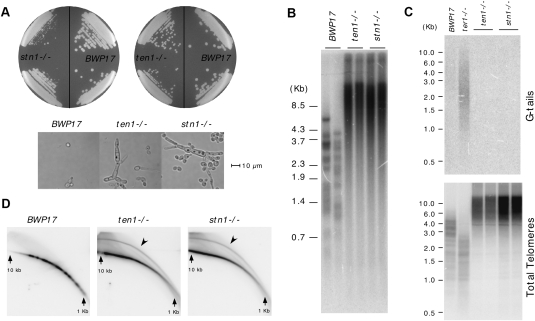Figure 1.
Phenotypes of the C. albicans stn1−/− and ten1−/− mutants. (A) The slow-growing and filamentous morphology of the stn1−/− and ten1−/− mutants are displayed. (B) Chromosomal DNAs isolated from the parental BWP17, the stn1−/−, and the ten1−/− mutants were subjected to Southern analysis of the telomere terminal restriction fragments. The mutant samples were from two independently constructed null strains that have undergone ∼100 cell divisions following construction. (C, top) Chromosomal DNAs isolated from the parental BWP17, the stn1−/−, and the ten1−/− mutant were subjected to in-gel hybridization analysis of the level of G tails. (Bottom) Subsequently, the DNAs were denatured in the gel and reanalyzed using the same probe. As a positive control, the DNA from a ter1−/− strain, which was demonstrated previously to exhibit an increase in G-tail signal, was analyzed in parallel. (D) Chromosomal DNAs isolated from the parental BWP17, the stn1−/−, and the ten1−/− mutants were subjected to two-dimensional gel electrophoresis in order to resolve linear and circular telomeric DNA (marked by arrowheads).

